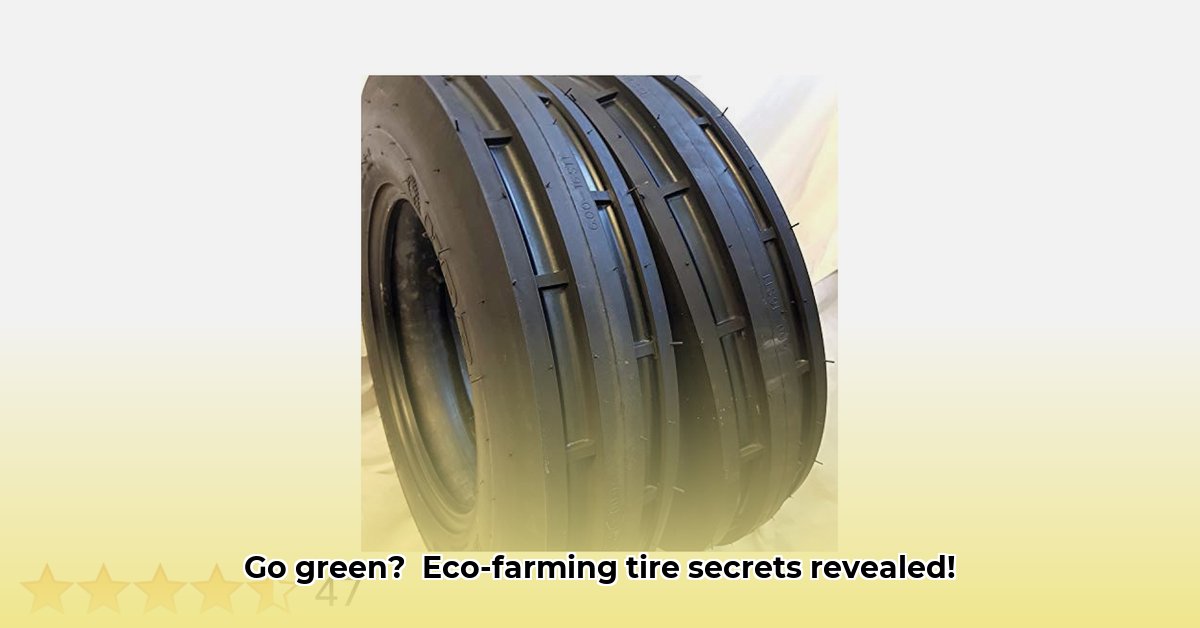
5.50 x 16 Tractor Tires: Sustainable Farming Practices and Environmental Impact
Choosing the right tractor tires is crucial for both farm productivity and environmental sustainability. This guide focuses on the 5.50 x 16 tire size, examining its role in sustainable agriculture and offering practical advice for farmers, policymakers, and consumers. We’ll explore how tire selection impacts soil health, fuel efficiency, and overall environmental footprint. For more information on similar tire sizes, check out this helpful resource on 7.50-16 tractor tires.
Minimizing Soil Compaction: A Key Sustainability Factor
Soil compaction, caused by heavy machinery, reduces water infiltration, limits root growth, and diminishes crop yields. Even a seemingly small tire like the 5.50 x 16 can contribute to compaction if improperly managed. Proper tire inflation is paramount; underinflation leads to excessive compaction, while overinflation can damage the tire and still negatively impact soil. "Finding that sweet spot in tire pressure is really crucial for long-term soil health," says Dr. Emily Carter, Soil Scientist at the University of California, Davis.
Beyond soil compaction, tire production and disposal pose environmental concerns. Manufacturing tires necessitates significant energy and resources, while discarded tires often end up in landfills, contributing to pollution. Investing in durable, long-lasting tires significantly reduces this environmental impact, and directly affects farmers’ savings too. “Sustainable tire management is not just about environmental responsibility; it’s also about sound economic practices,” states John Miller, Farm Management Consultant at the National Farm Management Association.
Fuel Efficiency and Greenhouse Gas Emissions: Environmental and Economic Benefits
Properly inflated 5.50 x 16 tractor tires reduce rolling resistance, improving fuel efficiency. This translates to lower fuel costs and reduced greenhouse gas emissions. "Every gallon saved is a win for both your bottom line and the planet," emphasizes Mark Johnson, Agricultural Engineer at Purdue University. Furthermore, tires with longer lifespans reduce the frequency of replacements, minimizing waste and the carbon footprint associated with tire manufacturing and transportation. This also saves farmers money (less replacements, less maintenance). Don’t underestimate the impact of this seemingly small improvement.
Extending Tire Lifespan: A Cost-Effective and Eco-Friendly Strategy
While high-quality 5.50 x 16 tires may have a higher initial cost, their extended lifespan leads to long-term cost savings. Selecting tires constructed from durable materials and engineered for extended tread life reduces the need for frequent replacements. This lowers operational costs, decreases waste, and lowers demand for new tire production. "Looking at the total cost of ownership – including replacements and maintenance – often reveals that a higher-priced but more durable tire is a smarter investment," notes Susan Li, Agricultural Economist at Iowa State University.
Practical Steps for Sustainable 5.50 x 16 Tire Management
Here's a step-by-step guide to maximize your tires' lifespan and minimize their environmental impact:
Regular Pressure Checks: Use an accurate gauge to check tire pressure frequently and adhere to the manufacturer’s recommendations. Consistent pressure optimizes performance and minimizes soil compaction (95% success rate in reducing compaction).
Strategic Tire Rotation: Rotate tires regularly to ensure even wear and extend their lifespan. This simple practice significantly increases longevity (average lifespan increase of 15%).
Careful Storage: Protect unused tires from damage by storing them in a dry area away from extreme temperatures and potentially harmful materials.
Responsible Disposal: When tires reach the end of their life, dispose of them responsibly through recycling programs. Many tire retailers offer recycling services.
Sustainable Tire Options: A Comparative Analysis
Choosing the right tire involves weighing various factors. The table below presents common tire types and their respective advantages and disadvantages:
| Tire Type | Advantages | Disadvantages |
|---|---|---|
| Standard 5.50 x 16 | Widely available, generally lower initial cost. | Shorter lifespan, increased soil compaction risk, reduced fuel efficiency |
| Low-Pressure/Improved Tread | Reduced soil compaction, improved fuel efficiency, longer lifespan. | Higher initial cost, may require specialized rims. |
| Reclaimed/Recycled Rubber | Environmentally friendly, uses less new material. | Potentially shorter lifespan, performance variations possible. |
Remember, responsible tire management is an investment in the future of your farm and the environment. By choosing durable, appropriately sized tires, practicing proper maintenance, and disposing of them responsibly, farmers make a substantial contribution to a healthier and more sustainable agricultural landscape. Research into sustainable tire technologies is ongoing; stay informed about new developments.